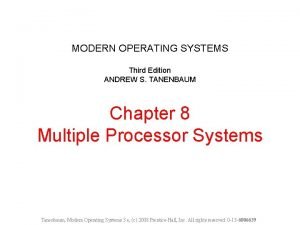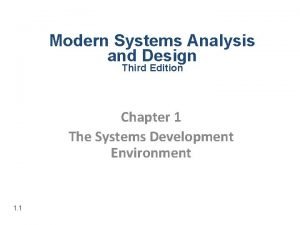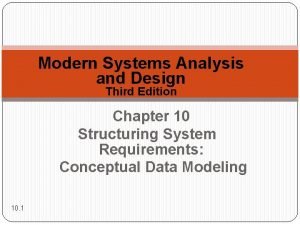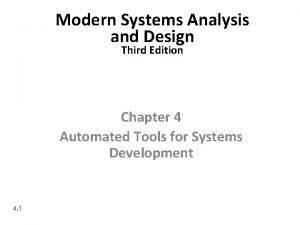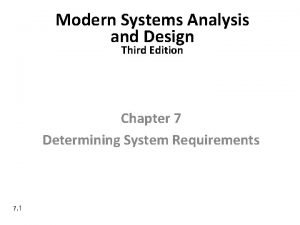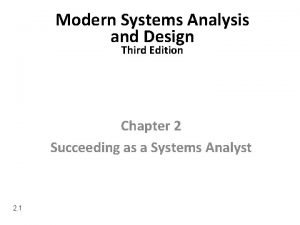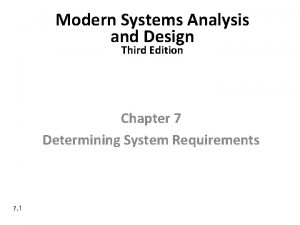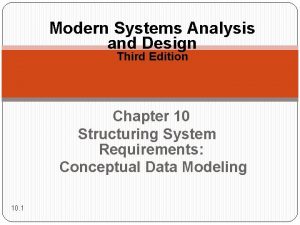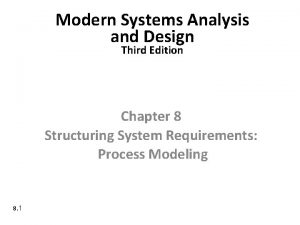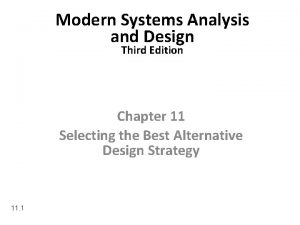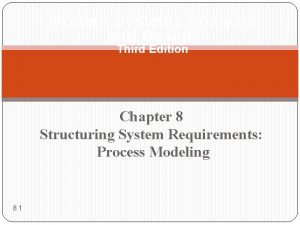Modern Systems Analysis and Design Third Edition Chapter











- Slides: 11

Modern Systems Analysis and Design Third Edition Chapter 5 Identifying and Selecting Systems Development Projects 5. 1

Identifying and Selecting IS Development Projects � Sources of projects �Management and business units – for replacing or extending an existing system to gain needed information or to provide new service to customers �Managers who want to make a system more efficient or less costly or to move to new operating environment �Formal planning groups – identifies projects for improvement to help organization objectives � Project Identification and Selection consists of: �Identifying potential development projects �Classifying and ranking projects �Selecting projects for development 5. 2

Identifying Potential Development Projects � Projects are identified by �Top management �Steering committee �User departments �Development group or senior IS staff 5. 3

Identifying Potential Development Projects Top Management n Greater strategic focus, largest project size, longest project duration Steering Committee n greater organizational change, formal cost-benefit analysis, larger and riskier projects User Department n faster development, fewer users and business functions Development group n Fewer development delays, less concern on cost-benefit analysis

Classifying and Ranking IS Development Projects �Focuses on assessing the relative merit of potential projects �Can be performed by top managers, steering committee, business units, or IS development groups �Criteria for assigning merit may vary and one or more than one criteria may be used 5. 5

Classifying and Ranking IS Development Projects Value Chain Analysis n Extent to which activities add value and costs when developing products and/or services Strategic Alignment n Extent to which project is seen as helping the organization achieve its objectives and goals Potential Benefits n Extent to which project is seen as improving profits, customer service and duration of these benefits Resource Availability n Amount and type of resources the project requires and their availability Project Size/Duration n Number of persons and length of time needed to complete project

Selecting IS Development Projects �Actual selection of projects for further development �Process of considering short and long-term projects �Projects most likely to achieve business objectives are selected �Decision requires consideration of: � Perceived and real needs � Potential and ongoing projects � Current organizational environment � Existing and available resources � Evaluation criteria 5. 7

Selecting IS Development Projects �Outcomes �Project Acceptance �Project Rejection �Delay �Refocus �End-User Development 5. 8

Identifying and Selecting IS Development Projects �Deliverables and Outcomes �Primary Deliverable �Schedule of specific IS development projects �Outcomes �Assurance that careful consideration was given to project selection �Clear understanding of project’s relation to organizational objectives 5. 9

Corporate and Information Systems Planning � Need for planning �Improperly planned projects result in systems that cannot be shared across an organization �As business processes change, lack of integration will hamper strategy and business process changes � Corporate Strategic Planning �Process of developing and refining models of the current and future enterprise as well as a transition strategy �Planning results in several outcomes �Mission Statement �Objective Statement �Competitive Strategy 5. 10

Corporate and Information Systems Planning � Corporate Strategic Planning �Mission Statement �A statement that makes it clear what business a company is in �Objective Statement �A series of statements that express an organization’s qualitative and quantitative goals for reaching a desired future position �Objectives are critical success factors �Competitive Strategy �The method by which an organization attempts to achieve its mission and objectives 5. 11
 Modern systems analysis and design 7th edition
Modern systems analysis and design 7th edition Modern system analysis and design
Modern system analysis and design Modern systems analysis and design
Modern systems analysis and design A modern approach to systems analysis and design
A modern approach to systems analysis and design Modern operating systems tanenbaum
Modern operating systems tanenbaum Modern operating systems 3rd edition
Modern operating systems 3rd edition Structured computer organization
Structured computer organization G j mount classification
G j mount classification Senile caries
Senile caries When to use sdlc
When to use sdlc Principles of economics oxford fajar pdf
Principles of economics oxford fajar pdf Reaction of grignard reagent with acid chloride
Reaction of grignard reagent with acid chloride




